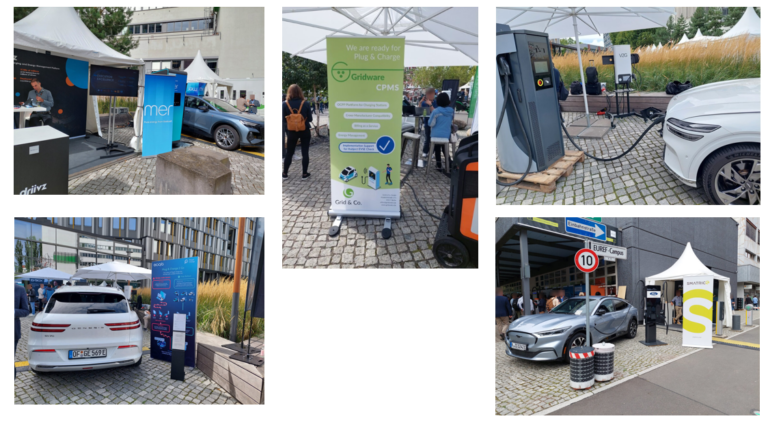ICNC is a wrap. Now in its eleventh year, once again, the conference proved to be one of the key events for the EV industry. This year, Hubject brought the conference forward by a couple of weeks hoping that would improve the chances for sunshine. For the most part, that move paid off and we enjoyed ideal weather – at least on the second day. But even the rain on the first afternoon did not deter people from bustling about the incredible EUREF campus in Berlin. While many came prepared, the neat white umbrellas that Hubject graciously handed out came in handy for those who needed one.

The whole EV charging ecosystem was there
As in past years, the conference brought together leading players across the EV ecosystem: CPOs, eMSPs, EVSPs, automotive OEMs, EVSE manufacturers, not to mention, EV Charging and Energy Management Platforms like Driivz. But there were also some innovative startups showing things like vertical parking solutions integrated with EV charging, and solutions that use AI to help CPOs plan where to rollout their EV charging infrastructure.

Evolving EV charging business models
This year’s theme was “Paths to Profitability – Next Generation Business Models for eMobility,” and there were plenty of talks around business models, customer experience, the expanding EV market and the need to scale up operations to meet the growing need for EV charging. There were talks that emphasized how participation in energy flexibility markets and demand side response systems can become a real source of revenue for companies using platforms that offer advanced energy management solutions for EV charging. Others mentioned the need for scalability, but not only in terms of managing charger operations, scalability must extend to billing operations, partner support, and EV charging apps. The sentiment was that when there’s a problem with the app, the operator gets blamed, and there was even a call for certifying EV charging apps. Dynamic pricing came up in different talks, with speakers citing successful use cases allowing the MSP to remain profitable while offering lower prices when possible. But one of the strongest messages that came out in the talks is that drivers want seamless simplicity when making payments – and that means credit cards. While putting payment terminals on charging stations adds a layer of complexity, this capability was cited as one of the key drivers guiding the near future of EV charging payment. And that brings me to the star of the show.
Plug&Charge is here to stay
Plug&Charge is on its way to being the preferred mode of operation in the EV charging ecosystem. Since last year, support for Plug&Charge has grown tremendously with dozens of CPOs, vehicle models, EVSE models, and EV charging management platforms currently supporting ISO 15118. The simplicity and seamless user experience, supported by robust security and scalability of the standard is currently unmatched. In addition to being the world’s largest EV charging roaming platform, Hubject is now establishing itself as the leading global V2G-PKI and Plug&Charge ecosystem operator – effectively, the leading certificate authority for PKI certificates used to implement Plug&Charge. In addition to our own Plug&Charge demo showcasing Driivz’s cooperation with Mer and Hubject, there were several other demos displayed at the EUREF campus.

The US is also getting on board with Plug&Charge bolstered by a requirement by the NEVI program that public chargers must support this capability by the end of February 2024 in order to get funding. California has taken it a step further and mandated that fast chargers installed after January 2024 must support Plug&Charge.
CharIN together with Hubject gave a talk about the goals of the OPCP – the Open Plug&Charge Protocol which were:
- Interoperability – to enable interfacing with other Plug&Charge systems
- Vendor neutrality – to avoid monopolies and enable anyone to participate
- Accessibility and inclusivity – to make it available to everyone
- Regulatory alignment – making it easier for businesses to comply with regulatory requirements by covering them in the protocol
- Longevity and legacy – to foster global adoption and reduce the risk of systems becoming obsolete
- Industry growth – to foster larger markets
- Consumer confidence – as the adoption grows and matures, consumers should be happy to use and come to expect this capability
While EV adoption is undoubtedly growing, consumer confidence in the industry is taking a hit. In their talk about new trends in charging, the speaker from S&P Global Mobility cited their survey of thousands of consumers and showed that the number of people who believe that EV technology is ready for mass-market adoption in their country has been declining since 2021.

Source: S&P Global Mobility at ICNC 2023
But we have to remember that the industry is still in its early days. The technology is still evolving, the business models are still being tested, government regulations are still in the works, standards are being set and bumps in the road are still being ironed out. It’s up to all those who attended ICNC, whether in person or virtually, to understand consumer sentiment, and address it until EVs become so commonplace that they will simply be referred to as “cars,” like the vehicles most people are still driving today. One thing is certain. Events like ICNC play an instrumental role in bringing the movers and shakers of the industry together, sharing their knowledge and experiences to help drive EV adoption for the betterment of everyone. Here at Driivz we’re so looking forward to next year’s event, and certainly hope to meet you there.




